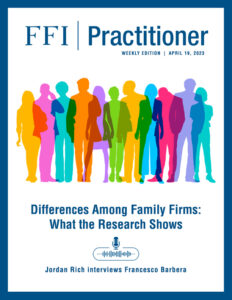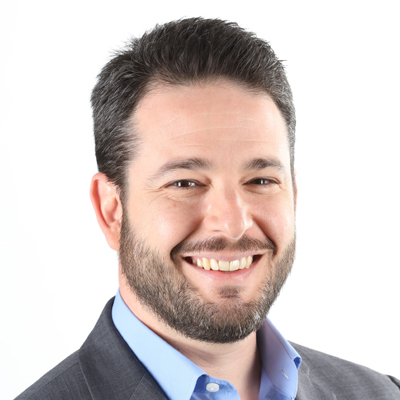
View this edition in our enhanced digital edition format with supporting visual insight and information.
The FFI Practitioner podcast is pleased to host GEN Faculty member and FFI Fellow Francesco Barbera, discussing heterogeneity among family firms. This discussion uses as its launching point the FFI GEN course 501, “Evidence-Based Advising: Using Research to Empower Family Enterprises.”
Podcast Transcript
Jordan Rich (JR): Welcome to the FFI Practitioner podcast. Today’s conversation is entitled “Differences Among Family Firms: What the Research Shows,” featuring Doctor Francesco Barbera. Frank Barbera is Associate Professor of Entrepreneurship and Strategy at Toronto Metropolitan University and is part of the GEN Faculty teaching the course “Evidence-Based Advising: Using Research to Empower Family Enterprises.”
So Dr. Barbera, let’s get right to it. What does the research show?
Francesco Barbera (FB): Family business is kind of a young discipline—it’s only been around for thirty years or so, which is interesting, because this is one of the oldest institutions on the planet. And yet, we’ve only really just started studying them in the last few decades. In the development of any discipline and field, there are stages that occur. The first stage, in this case, is just to establish the fact that family firms are different. And they are quite unique, and we can get into that, but ultimately those first rounds of inquiry were establishing the differences between whatever “a family business” is, and whatever a “non-family business” is. A lot of those first early studies did a very good job at establishing that yes, indeed, family businesses are different. But the problem is that a big assumption is made, and that assumption is that all family firms are the same, and all non-family firms are the same. We do need to study this, but of course, as the field progresses, that assumption of homogeneity within the groups is a pretty poor one. You start to relax that, and you start to go a little bit deeper, and ask, “Hold on a minute—in what ways are family businesses different?” In what ways are they different—not just in comparison to non-family firms, but in comparison to other family firms. Similar to ideas in strategy research, where you have an approach that assumes all firms are the same, then they go off and they purchase resources and capabilities, they scan the environment, they then acquire competitive advantages, and these competitive advantages are what distinguishes them from other firms. But ultimately, all firms can have the ability to go out and acquire these capabilities and resources, and they too can develop competitive advantages.
But then, the field progressed, we have the resource-based view approach, which is an internal idea of what distinguishes firms from each other, or what creates competitive advantage, and we see that not everything can be purchased. There are inherent resources and capabilities that do lead to competitive advantages. And in fact, all firms are unique. So, the opposite statement of “All firms are the same,” is that all firms are unique. Of course, the reality of things is that all families are unique, all individuals are unique, and therefore all family businesses are unique. As a discipline, as a group of scholars who are studying this phenomenon, [we] are starting to ask, “Well, then what are the differences?” Now we know there are patterns across family and non-family [firms], but what are the differences? It’s important because it takes the field to the next level. It’s important because it starts to allow us to go a little bit deeper into the nuances of what exactly are the unique challenges and opportunities that family business face. It’s not the same for all family businesses, but that said, we can go deeper and discover what those differences are.
JR: What are the implications for families, and certainly family advisors, if we continue to have a distorted, homogeneous view of family firms?
FB: There’s a lot of talk about best practices, because there are some patterns and there are some similarities, and you can always bring abstract out to those patterns and similarities. Then of course, best practices can be developed, and these are things like, “You ought to think about succession.” “You ought to develop a plan.” “By the way, family firms typically have a lot of emotions, are very emotionally laden, and therefore you ought to be mindful of that.” “By the way, family firms have the next generation up and coming, and we need to develop those people.” Another one is governance, “We ought to develop structures that govern the ways in which the family influences the business, or affects the business.” This is all well and good, but the problem is when you have a vanilla, blanket approach, [with] one solution to all problems, then it’s pretty obvious that that becomes problematic. Again, all families are unique, all family firms are unique, and so there’s not going to be one solution from an advisory perspective that is solving all the problems. I think it’s the same idea—suffice to say that family firms are different, and yet there are some key practices, what you might call “best practices,” that ought to be followed. But to not go any deeper than that, to blindly follow a best practice without understanding the heterogeneity that does exist can be very detrimental, obviously, from an advisory perspective, because then we have advisors who are not necessarily delivering the best advice and offering the best interventions.
JR: Dr. Barbera, share with us a bit about the theory of family science, how it applies to our discussion today and how it’s evolving.
FB: As you know, I would call myself a researcher in this space. There’s no exhaustive list in terms of the ways in which family firms can be different, but I can name a few. It starts with these ideas about why is it that family firms are different. One of the arguments in the literature is this idea of socioemotional wealth. I’m sure the audience will be familiar with this concept, but to summarize really crudely, it’s essentially the affective value that families gain and accumulate and the benefit that they receive based on non-economic attributes. The old economic perspective of a business is simply that the purpose of that business is to maximize profit for its owners. But of course in a family firm—and by the way, this is not just for family firms, but socioemotional wealth was a concept that was born out of the family business literature—in a family firm, they don’t just care only about profit, there are other factors that add value and [that] they want to maximize. And those are things like their reputation; their control (which in and of itself gives them a sense of satisfaction); keeping it in the family—their whole identity is wrapped up in this business, the emotions of others and keeping everybody happy; and finally, the relationships that [they] develop with customers and suppliers and so on in the community. These are non-economic, although they may lead to economic consequences, ultimately. They in and of themselves are values that want to be maximized, sometimes even to the detriment of economic value.
You asked what’s going on in the literature with respect to heterogeneity. In the old days—so to speak, not that old, maybe ten years ago—socioemotional wealth came out as a big concept. There was this assumption that family firms value or pursue socioemotional wealth, and non-family firms do not. But of course, when you understand the heterogeneity perspective, you think, “Well, what aspects of socioemotional wealth do different family firms pursue?” Maybe a fifth-generation family business is more interested in reputation and identity, rather than control. Maybe a first-generation family business is more interested in keeping it in the family or in the social capital that they’ve created within the community. There’s going to be variation across family business in terms of what aspects of socioemotional wealth they care about. If you go one step further, there are also going to be differences within each individual family, in terms of whether or not, or the extent to which, they value socioemotional wealth. You may have a patriarch who is extremely interested in reputation, and then you may have a next-generation or a rising generation son or daughter who is more interested in identity. So there’s going to be variation even within the same family. But to date—or I shouldn’t say “to date,” because now the research is being done in these areas, but it’s burgeoning, and it’s up and coming—up until more or less this point, there’d been this assumption [that socioemotional wealth was applied to] the entire family, and sometimes [to] the whole group of family businesses. That’s one area that’s being worked on—the extent to which socioemotional wealth is affecting behaviors and outcomes for family businesses. But there are all kinds of other interesting areas that are [being studied], for instance with respect to governance and the configuration of best practices around governance, [as well as] entrepreneurial orientation, these are all areas that consider the fact that it’s not a one-size-fits-all explanation for these groups of people. Even within the family group, it consists of individuals, and those individuals have their own minds and hearts and souls, [and] you cannot say they’re all the same.
JR: So the benefits of understanding the sources, types, and variances of heterogeneity among family firms can put the advisor in a better place, and can really help the family socially and economically.
FB: Absolutely. There’s this interesting idea, with socioemotional wealth as an example, there is this argument that sometimes non-economic objectives are pursued to the detriment of economic objective. But when you factor in time, who’s to say that something that you do now, in terms protecting your family name and therefore deciding to remain a little smaller and not grow, that that wouldn’t pay off later on, when you consider the bigger picture, the temporal aspects of things? Similarly, for an advisor, it’s about looking at the bigger picture. We talk about heterogeneity, we can talk about levels, so there’s the macro level, the mezzo level, and the micro level. When you go down the rabbit hole of thinking about heterogeneity, then you realize that no two things are the same ever. Even the same thing itself has changed across time. So, even you yourself, Jordan, are not the same Jordan that you were yesterday. There’s heterogeneity even within you! So, once you understand the nature of that phenomena of difference and change, then you realize that nothing stays the same and as an advisor, you must consider that fact if you really want to be the most effective advisor you can be.
JR: Dr. Barbera, they say the only thing constant in life is change. And you and your colleagues seem pretty energized, keeping up with these changes and sharing them with the rest of us.
FB: This is about the [GEN] 501 course that we recently revamped. I’ve been teaching this course for more than ten years now, so I’ve seen the different iterations of the course. Most definitely, this version is the best version so far. But in the spirit of change, it will continue to improve. I do get that feedback, that the advisors are thinking, “Wow, that’s actually a much deeper and more insightful way to think about families in business and business families.” That’s what makes family business so cool, right? Family business is about that intersection of the economic-business-technical world and the human-relational-emotional world. Automatically that creates a very interesting scenario and a very interesting area of study. And then when you factor in what we’ve been talking about today, you think, “Wow, how nuanced is this?” It’s a little bit overwhelming. As I said in the beginning, you do need an initial starting point to say, “Hold on, family firms are different.” And so you do need some assumptions to say there are some patterns that family firms all exhibit. But beyond that anchoring, we can really explore. I love FFI because they’re so good at translating and connecting the researchers with practitioners. It’s such an interesting time for practitioners now to really accept this, embrace it, and as I said before, to thrive as an advisor.
—
JR: Thank you to Dr. Francesco Barbera for this conversation. Listeners who are interested in learning more about this topic or enrolling in the GEN certificate programs should visit ffigen.org. For more information on FFI Practitioner, go to ffipractitioner.org. I’m Jordan Rich. Thank you for listening!
About the Contributor

Francesco Barbera, PhD, FFI Fellow, is an Associate Professor of Entrepreneurship and Strategy at The Ted Rogers School of Management at Toronto Metropolitan University. The recipient of the 2014 Outstanding Reviewer for Family Business Review and co-recipient of the 2019 FBR Best Article Award, he researches a wide range of economic issues applied to family business and entrepreneurship. He can be reached at francesco.barbera@torontomu.ca.
Jordan Rich is celebrating a quarter century at one of America’s top legacy radio stations, interviewing thousands of celebrities, authors, actors, and interesting personalities throughout his career. Jordan is co-owner of Chart Productions Inc. and teaches voice-over acting. His main focus these days is in podcast creation and production, featuring conversations with the world’s most creative people.

View this edition in our enhanced digital edition format with supporting visual insight and information.





